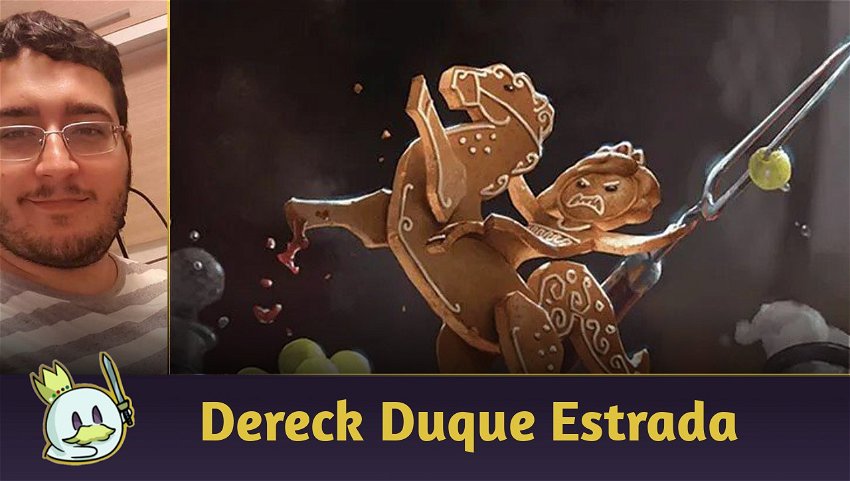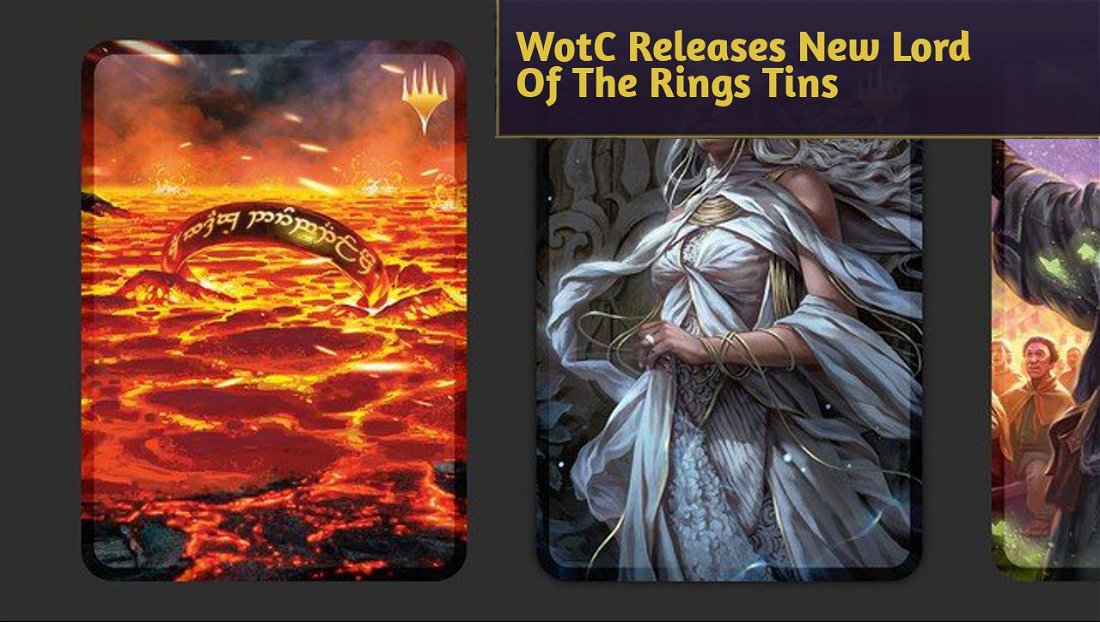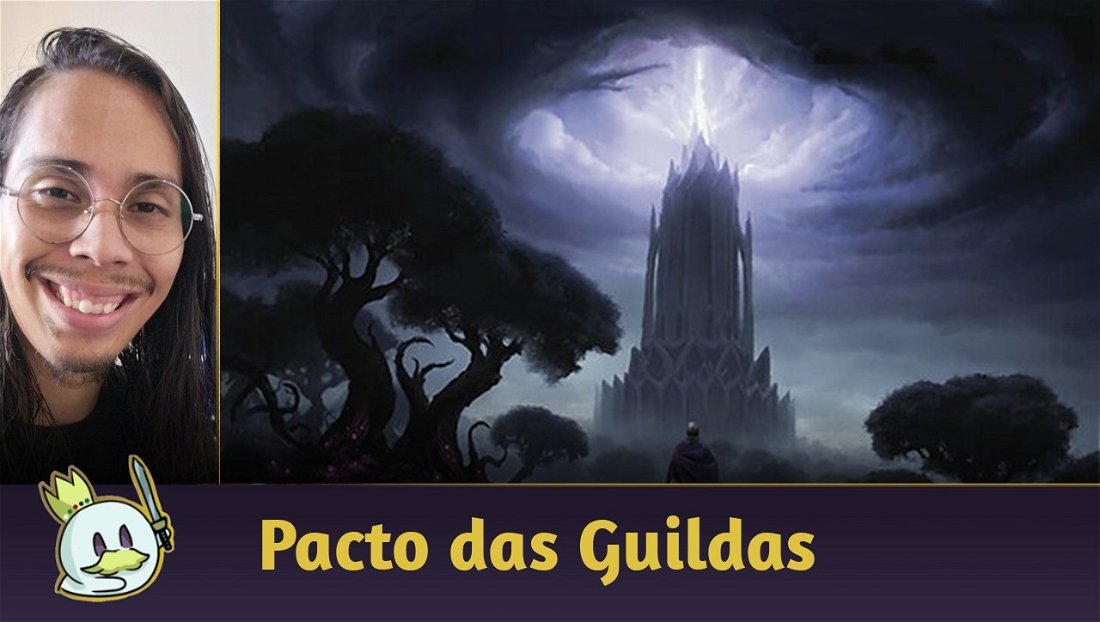Introduction
As the events of New Phyrexia have come to a close, it's time to see how the planes are dealing with the collateral damage from this battle between planes, and the first focus is on Eldraine's plane.
The first time we went to Eldraine was very iconic in Magic, particularly to me - Thrones of Eldraine was my first Magic Pre-release event, and it was life-changing for me to play in stores and in Magic Arena. For a long time, I used cards such as Fervent Champion, Torbran, Thane of Red Fell, Bonecrusher Giant and saw many other cards steal the spotlight in many formats, mainly in Standard.
Ad
Cauldron Familiar and Witch’s Oven moved Aristocrats through Standard in Pioneer; Oko, Thief of Crowns caused a riff, and ended up banned in almost all formats it played in. Other cards also had spotlight in Standard, and even got some bans of their own.
Throne of Eldraine presented very strong mechanics and cards for the constructed formats, but, besides that, it led to a very diverse Limited format. The Adventures allowed for a better setup for deckbuilding, as, with only one card, you could already have a removal and a creature. This trait allows us to explore deckbuilding in a much more meaningful way, and best take advantage of these extra slots which are provided by the Adventure cards.
Well, without further a do, now is the time to venture into a fallen realm's lands, as it tries to reestablish itself after the biggest war they have ever faced. It's time to go into the Wilds of Eldraine.
Limited in Wilds of Eldraine - WOE
As expected, Wilds of Eldraine is back with two mechanics which were explored in Throne of Eldraine: Adventures and Food Tokens. But, in WOE, we have the addition of 3 new mechanics: Bargain, Roles and Celebration.
Besides that, there are Enchanting Tales, which are enchantments which can be found in boosters, but aren't part of the set, considered cards of their own, just like the spells in Strixhaven's Mystical Archive.
So, if you open up a Necropotence, it will become a part of your Limited game pool in Sealed formats, in Drafts you'll be able to decide whether you pick it or not, and in case you do, you'll be able to include it in your deck when you build it.
Mechanics
Adventure
Adventure cards are back: with a new wave of cards and upgrade to its design, in WOE we have Adventures with a mana color cost which is different from the creature's color. In these cases, the card's color is the creature's, and, for any game effect, it will only represent the Adventure color when the Adventure spell is cast.
As I discussed previously in the introduction, Adventure cards are very relevant pieces for deckbuilding as we have two effects in a single card, this way being able to access more interactions and effects without losing the creature slots.

Bargain
This is a mechanic which seems like Kicker, but with the following cost: "sacrifice an artifact, enchantment or Token". Basically, it is an alternative cost for the spell's abilities, creating an extra effect or altering the card's effect, such as in Torch the Tower.

Food Token
Another mechanic which is back in Eldraine is the Food Tokens. Here in WOE, they have an important interaction with Bargain and other cards which take in consideration the presence or sacrifice of artifacts, Tokens or permanents.
Ad
Besides that, its potential life gain is a very relevant factor in very close matches.

Role Tokens
Role Tokens are nothing more than auras which enchant creatures, with up to 6 types available in the set.
Cursed - The enchanted creature has basic power and toughness equal to 1.
Monster - The enchanted creature gets +1/+1 and has Trample.
Royal - The enchanted creature gets +1/+1 and has Ward {1}.
Sorcerer - The enchanted creature gets +1/+1 and has “Whenever this creature attacks, Scry 1.”
Wicked - The enchanted creature gets +1/+1 and “When this Aura is put into a graveyard from the battlefield, each opponent loses 1 life.”
Young Hero - The enchanted creature gets “Whenever this creature attacks, if its toughness is 3 or less, put a +1/+1 counter on it.”

Each creature can only have one Role Token controlled by the same player. In case another is added, the oldest Role is placed in the graveyard and the most recent one is attached to the creature.
Another relevant point is that these auras can be used to pay for the extra cost to activate cards' Bargain effects, which enhances the effects of these cards. Another important factor that can exist is for cards which take in consideration the number of permanents on board or that have entered the battlefield on that turn.

Celebration
Celebration is a mechanic which evaluates the entry of non-land permanents on the battlefield on that turn, triggering an effect when it happens.
In this set, this mechanic is only found in the colors Red and White, with a very big interaction with permanents which create Food Tokens or permanents which create Role Tokens.

Archetypes in the Set
Now that the set's mechanics have been evaluated, it's time we look at the archetypes. Here, we'll separate them by color pairs, as it isn't possible to get combinations with 3 or more colors and still have synergies.
Azorius Tap
Our first archetype is based on tapping your opponent's creatures, with a game plan more focused on delaying your opponent as you move forward.
Hylda of the Icy Crown and Icewrought Sentry give out excellent payoffs in this archetype, and Sharae of Numbing Depths Hylda’s Crown of Winter and Solitary Sanctuary will be the cards which will sustain it.
Vantress Transmutercomes in as an option with synergy with a relevant body after casting the Adventure. Another efficient Adventure card in the archetype is Threadbind Clique, which has a relevant body with evasion and an instant speed removal which is extremely synergistic.
Ad
Galvanic Giant, despite seeming like an excellent fit for the archetype, is dependent on heavy spells which don't really fit the card itself.
Horned Loch-Whale can be an excellent finisher, as it can be cast at instant speed with a very relevant Adventure to delay your opponent's progress.

Best Common Cards

Best Uncommon Cards

Orzhov Enchantments Sacrifice
Moving on to the white and black color combination, we have a focus on their enchantments and sacrifices, with cards which care when enchantments go to the graveyard. The Role Token mechanic is used to put enchantments on board, and the Bargain spells are used to sacrifice enchantments and to optimize the spells' effects, providing synergy for the archetype.
Spellbook Vendor shows up as a good engine for the mechanic, being able to create enchantments every turn and also force them to go to the graveyard in case you put Sorcerer Token on a creature which is already enchanted with another Role Token.
Another interesting effect is taking advantage of the Bargain spells alongside The Princess Takes Flight saga to follow through the 2 first chapters and then sacrifice the saga as the spell's cost with Bargain. This way you'll avoid having the exiled creature return to the battlefield as the third chapter doesn't happen, transforming it into an excellent removal.
Neva, Stalked By Nightmares is an excellent reason to be in this combination, just like Eriette of the Charmed Apple, in this case with a bigger focus on creating Role Tokens.
Another key point in this deck is the balance among the cards used to sacrifice enchantments and cards which put enchantments on board. In these cases, cards which create Role Tokens are very efficient, as they can do all the necessary effects.
Ashiok’s Reaper, Savior of the Sleeping, Wicked Visitor and Warehouse Tabby are good engines for the archetype, creating effects on top of the sacrifices.
Devouring Sugarmaw is a finisher option with good synergy; Lich-Knights' Conquest can take advantage of artifacts, Tokens and enchantments on the board without much impact in the game to return your creatures which have gone to the graveyard back onto the battlefield.

Best Common Cards

Ad
Best Uncommon Cards

Boros Celebration Aggro
As it was expected, the red and white combination brings us an archetype focused on being aggressive and creating permanents as early as possible, besides exploring to the maximum the Celebration mechanic, with Ash, Party Crasher as the main piece.
In this archetype, cards which create 2 creatures or which create Role Tokens are very efficient in helping us increase the board and put more damage in.
Goddric, Cloaked Reveler and Raging Battle Mouse are the other cards which take advantage of this kind of strategy. Heartflame Duelist, besides being quite aggressive, is also an excellent removal in the archetype.
Kellan, the Fae-Blooded is capable of growing the power of your board, besides being a creature with a really nice attack potential, even more so when combined with auras.
Imodane’s Recruiter can be combined by placing 2 bodies on board so that you can then increase the power of the whole board, giving everyone Haste.
Regal Bunnicorn is the perfect fit for this archetype, as it grows its power and toughness according to the way we increase our board.

Best Common Cards

Best Uncommon Cards

Selesnya Tokens
In the green and white combination, we have an archetype focused on Tokens, but the archetype isn't solely focused on creating creature Tokens as is the standard for this color combination: in WOE, the idea is to create Role Tokens, Food Tokens, and the standard creature Tokens.
Syr Armont, the Redeemer works as a way to increase the power of your enchanted creatures, besides being an excellent body on board. As for Yenna, Redtooth Regent, it allows you to increase the number of enchantments that are on board, and that works with Role Tokens - as long as they aren't placed on the same creature, there should be no problems.
Another way to play this archetype is to combine Pollen-Shield Hare with creature Tokens, or even with Tough Cookie, which allows you to transform your Food Tokens into creatures, as they are artifacts, this way being able to receive Pollen-Shield Hare's bonus.
The Huntsman's Redemption and Gruff Triplets are good ways to create Tokens, and sagas in particular have a very powerful synergy with Yenna, Redtooth Regent. They can be copied, creating all effects again, and when one is over, you can copy the copy and repeat the process as many times as it is interesting to do so.
Spellbook Vendor can be very effective with Syr Armont, the Redeemer, as all creatures can have their own auras be maximized in power because of this card.
Ad

Best Common Cards

Best Uncommon Cards

Dimir Faeries
In the blue and black combination, we have the archetype which takes into consideration the creature type, in this case, Faeries. Cards in this archetype will create effects when Faeries go on board, or they'll have better effects if you control a Faerie.
Obyra, Dreaming Duelist or Talion’s Messenger are very good options in this archetype.
Another interesting point is that because it is a Faeries archetype, your creatures will naturally have evasion, which will be a further complication for your opponent's to deal with.
Talion, the Kindly Lord is a card which is more efficient in Constructed than in Limited, but it is still an excellent body which will occasionally provide card advantage and attack your opponent's health points. Another interesting card is Barrow Naughty, which makes it possible for you to take advantage of the free mana to deal more damage, and, if you control a Faerie, you'll have Lifelink.
Furthermore, the archetype may work as a Tempo or Midrange deck, as it is possible to take advantage of the blue cards which transform into a creature or return cards to player's hands to delay your opponent while you advance your game plan, making use of Snaremaster Sprite and instants or sorceries which have similar effects.
Another option is to use more interactions. On that note, Chancellor of Tales and Mocking Sprite are cards which allow you to better take advantage of interactions with your opponent, being able to reduce the cost of building your board and decide the game on late turns.
Sleep-Cursed Faerie, despite its effect, can be very useful in cases when you have free mana left, being able to deal a good amount of damage with evasion.

Best Common Cards

Best Uncommon Cards

Izzet Spells
In the colors blue and red, we have the Spells archetype, using cards which gain tempo, and removals and cantrips that trigger effects and evolve your game plan.
Usually, the archetype suffers with balancing creatures and instants/sorceries, many times tending to have fewer creatures, and using a lot of protection for their creature and removals to guarantee the control of the game early on. With Adventure cards, that problem is reduced considerably.
Ad
Frolicking Familiar, Unruly Catapult and Aquatic Alchemist are good aggression pieces for the archetype.
Mocking Sprite, Chancellor of Tales and Johann, Apprentice Sorcerer are good support cards for the archetype, helping you build your set-up and evolving attacks.
The Apprentice’s Folly is an interesting saga which can work as an excellent finisher or even increase the effects of relevant pieces.
Hearth Elemental can provide new fuel after the cards in your hand run out with Adventure, and, as a creature, is an excellent card when combined with Song of Totentanz and Stonesplitter Bolt.
Imodane, the Pyrohammer is a card that can transform your removals into direct burn.

Best Common Cards

Best Uncommon Cards

Simic Ramp
In the blue and green combination, we have a game plan with a focus on ramp to cast spells that cost five mana or more, creating effects on permanents which are on board.
Bramble Familiar, Rootrider Faun and Troyan, Gutsy Explorer are essential pieces to speed up the game and to be able to use decisive pieces such as The Goose Mother, Gruff Triplets, Horned Loch-Whale or Thunderous Debut
Up the Beanstalk can represent considerable value after the ramp setup is built, allowing that, when heavier spells are cast, they become answers in your hand.
Skybeast Tracker, Tempest Hart, Galvanic Giant and Stormkeld Prowler are examples of cards which benefit from this strategy.
The risk with this type of strategy is not finding the payoffs or not finding ramp pieces, so it is very important to know which hand you'll choose to start the match with.
The other two cards which interact well with this archetype are Beanstalk Wurm, which allows you to advance a land turn with your Adventure - besides being a creature with a relevant body, and Elusive Otter, which in its Adventure allows you to share counters, being able to make a board unbalanced or increase the damage which is needed to close the game.

Best Common Cards

Best Uncommon Cards

Ad
Rakdos Rats Tokens
In the black and red colors, we have a synergy with Rat Tokens, which allow you to go towards a more aggressive line of filling the board and attacking the opponent with Tokens. There are many ways to deal with the game, be it by forcing trades with Totentanz, Swarm Piper or Tattered Ratter and closing the match with Gnawing Crescendo or Lord Skitter’s Butcher, allowing you to deal more damage after you build a relevant board.
Another value line is taking advantage of Tokens and using the Bargain spells to enhance their effects, such as High Fae Negotiator and Stonesplitter Bolt.
Redcap Gutter-Dweller is an extremely efficient card for this archetype, presenting evasion, creating Tokens for a more aggressive strategy, or to serve as fodder in a strategy which explores the Bargain spells more or to be sacrificed by the card itself, providing card advantage and increasing its power.
Song of Totentanz is an excellent way to feed the archetype and Twisted Fealty can be used as removal when allied to the possibility of sacrificing creatures.
Rankle's Prank can work as the final charge against your opponent when resources are already scarce, being able to close the game with 4 damage to you and the opponent.

Best Common Cards

Best Uncommon Cards

Golgari Food
In the black and green combination, we have the interaction with Food Tokens, be it to use the Bargain spells or even to create value.
Greta, Sweettooth Scourge is one of the main cards for this strategy, being able to both create card advantage and increase power on board, besides placing a Food Token on the board as soon as it comes in.
Mosswood Dreadknight, despite not having synergy with the mechanic, is an extremely powerful card, being able to keep itself on board when cast, besides working as a shield until you find the necessary solutions for the enemy board and serving as a source of attack, forcing trades in which you'll preserve this creature.
Feed the Cauldron and The Witch’s Vanity are excellent removals for the archetype, and Mintstrosity and Scream Puff make it possible to have positive trades, serving as engines in the deck as well.
Sweettooth Witch, Hollow Scavenger and Night of the Sweets' Revenge are cards which take advantage of Food Tokens while they feed the battlefield with them.
Gumdrop Poisoner can take advantage of the life gain from Food Tokens and can remove relevant creatures from the board.
Restless Cottage can act preventing the return of cards from the graveyard while it creates Food, as another excellent piece to support the archetype.
Ad
Elvish Archivist and Syr Ginger, the Meal Ender are other extremely efficient creatures in the archetype, which tend to grow considerably when we increase the availability of the consumption of Food in the match.

Best Common Cards

Best Uncommon Cards

Gruul Stompy
To close it out, we have the green and red combination bringing an aggressive archetype. However, unlike Boros, which focuses on smaller creatures in high quantities, Gruul tries to scale the curve progressively by having bigger creatures after bigger creatures.
Alongside that, the archetype presents synergy with creatures with power above four, creating benefits to other permanents.
Ruby, Daring Tracker, besides having synergy with the archetype, works as a ramp for us to get to the mana needed for bigger creatures. Picnic Ruiner and Territorial Witchstalker are quite aggressive cards which take advantage of the deck's strategy well.
Spells which place +1/+1 counters or Role Tokens are quite effective, being able to provide what is needed to reach the necessary power and enhance the permanents on board.
Ferocious Werefox, Merry Bards and Curse of the Werefox are good examples.
Bestial Bloodline or Bespoke Battlegarb allow you to increase power permanently, which can be relevant for the game's development.
Agatha’s Champion can be used as removal at the same time it is a body on board.
Questing Druid is a piece which comes in early on board and tends to grow for each color different from Green that we use, being able to pass a considerable amount of damage in very little time.

Best Common Cards

Best Uncommon Cards

Mana Correction
Another relevant factor for Limited is the mana color correction, as the main source are the dual lands, but they aren't as available as you'd like to.
Edgewall Inn is useful to adjust the mana curve, and is an excellent option for correction.
Evolving Wilds is another option to correct the available colors.

Ad
Mana Filters
Some options to filter mana are Prophetic Prism, as the first choice, as its ability to provide reposition is important when it comes to resource management. Scarecrow Guide comes in as another option, having the advantage of activating the filter once per turn, but its problem is that it is easily removable as it is a creature.
Lastly, we have Crystal Grotto, which can be a game delay, as 2 lands are necessary to produce one mana, but in situations without other options for correction, it is better to use it than go without the adjustment.

Removals
In a format in which creatures are the main ways of winning matches, removals are vital points for the game's development, and are very important to understand the reach of each one in the set.
This way, we'll observe the reach of each of the main removals.
Rat Out is a removal which can hit around 19% of the creatures in the set, being more effective against Red, hitting 8 different cards.
Torch the Tower, without paying its Bargain cost, hits around 45% of the creatures in the set, being more effective against Red, hitting 15 different cards.
Kellan’s Lightblades, without paying its Bargain cost, hits around 73% of the creatures in the set, being more effective against blue creatures, which have toughness equal to 3 in most cases.
Cut In hits around 91% of the creatures in the set, being more effective against green or multicolored creatures which are mostly cards with 4 toughness.
Witchstalker Frenzy hits around 95% of the creatures in the set, being able to removal all multicolored creatures.
Feed the Cauldron is capable of acting against approximately 65% of the set, and is a good removal for early game.
The Witch’s Vanity, on the other side, hits around 37% of the set, and, despite not reaching much, is capable of removing important pieces in some archetypes and progressing with its saga effects.
A very important note: with the possibility of using Role Tokens, some removals can have their reach altered. It is important to take that into consideration when you work with removals.

Final Words
For me, this is the return to where it all began, and this way I couldn't make the most out of Throne of Eldraine. For Wilds of Eldraine, I intend to make the most out of all the various synergies between the cards and feel the nostalgia of playing a set on the plane which was my first experience with pre-releases.
From previous experiences, the Food mechanic has always been strong in Limited, gaining tempo in matches which many times were over already - so I expect a lot from decks based on this mechanic.
What about you, do you have a favorite archetype?
Which archetype are you most excited about?

Ad
Well, folks, this is my cue, but just remember that the pre-release's goal is to get to know the set and enjoy Magic! So, take advantage of this moment and help your friends build their deck, understand what the cards do, and mostly, have fun!
I'll see you in the next article. Cheers and see you then!














— Kommentare0
Sei der erste der kommentiert